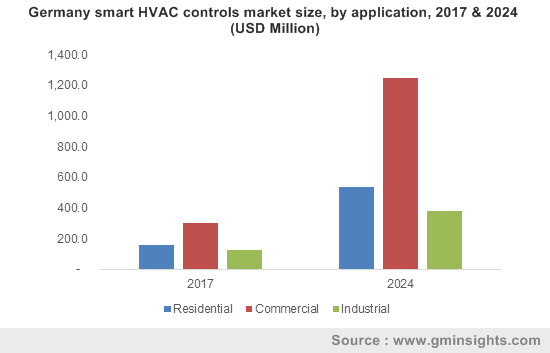HVAC controls market to accrue substantial returns from commercial applications, North America to emerge as a key revenue pocket over 2018-2024
Publisher : Fractovia | Published Date : 2019-07-02Request Sample
Rapid adoption of smart technologies across a host of residential, commercial and industrial applications has fueled the HVAC controls market, with increasing number of technology and energy startups cropping up worldwide. Several sensors integrated with building systems continuously gather data on the conditions throughout the structure, assisting the HVAC system adjust itself according to the changing needs. Easy control of thermostats sing devices like smartphones, tablets and voice assistants has propagated the expansion HVAC controls industry into private homes and apartment settings. The need for cutting down energy costs significantly and lower the dependence on maintenance staff will further generate demand for the HVAC controls market.
Germany smart HVAC controls market size, by application, 2017 & 2024 (USD Million)

Energy efficiency, globally, has become a key focal point for governments and organizations for meeting ambitious consumption and energy saving targets over the next few years. By controlling heating, ventilation of air conditioning to reduce energy usage in unoccupied areas of a building, smart thermostats and other equipment help to move closer towards those goals. Building automation has gained immense momentum in recent years, supporting the HVAC controls industry growth. Studies have shown that building automation can reduce up to 27% energy consumption in homes and almost 23% in office environments.
The International Energy Agency (IEA), separately, reported in 2017 that digitalization can result to nearly 10% energy savings in commercial and residential buildings by 2040, with the most remarkable savings achieved in cooling and heating applications. IEA attributes these results to the increased installation of smart thermostats and sensors, emphasizing on the prospects for the HVAC controls market. These equipment essentially enable demand control and constant developments in technology have enhanced their response times to regulate according to fluctuating needs. Thermostat sensors can now detect variances in each zone, determining where temperatures change fast, or which rooms get chillier.
A recent global survey encompassing about 2,000 energy and facility management executives revealed that almost 57% of U.S. organizations intend to accelerate investments into energy efficiency over the next year itself. Divided into various investment avenues, it was found that 68% of these organizations plan to implement building control enhancements for saving energy. The survey has given a glimpse into the massive revenue potential for the North America HVAC controls market, with many government and corporate initiatives contributing towards the overall growth. A notable initiative would be the investments announced by Connecticut state’s venture capital arm, Connecticut Innovations.
To elaborate, the U.S. state has decided to allocate about USD 3.9 million in a global incubator over a two-year period, to encourage companies that are developing pilot programs in smart building and aged care segments. This will also open up considerable opportunities for the HVAC controls industry in the state, as integration of smart vents and thermostats have become a vital part of smart building technologies. Citing an instance to describe the existing position of HVAC control offerings in North America, Minnesota-based 75F Inc. in November 2018 unveiled the smartest commercial thermostat available in the market.
Speaking further, the company’s Smart Stat Zone Controller is built on cloud-based wireless building automation HVAC platform, providing information on temperature, CO2 levels, humidity, sound, light VOCs as well as occupancy of rooms and zones. Ideal for controlling lighting, indoor air quality and HVAC systems, the product can help achieve around 30 to 50% energy savings for commercial spaces. Innovative features in advanced thermostats, like detecting the number of people in a room and adjusting to the condition changes, are increasingly affirming the role of the HVAC controls industry in lowering costs in commercial surroundings.
All in all, the HVAC controls market in North America will capitalize tremendously on the large number of technology companies in the U.S. and Canada that are working towards delivering efficient energy utilization. Rising investments in alternate energy sources and their implementation in commercial buildings will boost the adoption of smart building control and improved energy distribution. Seeking new innovations to cover additional grounds and gain a bigger market share, key players in the HVAC controls industry include Distech Controls, Emerson Electric, Ecobee, Honeywell International, Johnson Controls, Lennox and Schneider Electric.